口译中的常见缩写和符号表示法
- 格式:doc
- 大小:40.00 KB
- 文档页数:7

口译中最常见的缩写(推荐五篇)第一篇:口译中最常见的缩写口译中最常见的缩写一、缩略词英语当中缩略词使用的频率很高,如IMP: important, ASAP: as soon as possible。
很显然如果能熟练掌握缩略词,会对考试大有裨益。
缩略词的写法一般为四种方式: 1.拿掉所有元音 MKT: market MGR: manager MSG: message STD: standard RCV: receive 2.保留前几个字母 INFO information INS insurance EXCH exchange I owe you IOU In stead of I/O 3.保留开头和结尾的发音字母WK week RM room PL people 4.根据发音 R are THO though THRU through 高级口译听力常用英语缩略词表缩略词原词APT Apartment ACC Accountant ACDG According ACPT Accept AD Advertisement ADS Address ADV Advice AMAP As much/many as possible AMT Amount APV Approve ASAP As soon as possible BAL Balance BLDG Building CERT Certificate CFM Conform CNCL Cancel CNF Conference CMI Commission CMP Complete CMPE Compete/competitive CMU Communication CONC Concern/concerning/concerned COND Condition pany DEPT Department DISC Discount DPT Departure EXCH Exchange EXPLN Explain EXT Extent FLT Flight FNT Final FRT Freight FYR For your reference GD Good GUAR Guarantee H.O.Home office INFO Information IMPS Impossible IMP(T)Important INCD Include INDIV Individual INS Insurance INTST Interested I/O In stead of IOU I owe you IVO In view of MANUF Manufacture MDL Model MEMO Memorandum MGR Manger MIN Minimum MKT Market MSG Message NCRY Necessary NLT No later than OBS Observe OBT Obtain ORD Ordinary PAT Patent PC Piece PKG Packing PL People PLS Please POSN Position POSS(BL)Possible PRODProduct QLTY Quality QUTY Quantity RCV Receive REF Reference REGL Regular REP Representative RESN Reservation RPT Repeat RESPON Responsible SEC Section SITN Situation STD Standard TEL Telephone TEMP Temporary TGM Telegraph THO Though TKS Thanks TRD Trade TRF Traffic TTL Total U You UR Your WK Week WL Will WT Weight XL Extra large二、字母、图像Z 表示“人” people/person,因为 Z 看上去像个人头,它通常被写在一个词或符号的右上角。
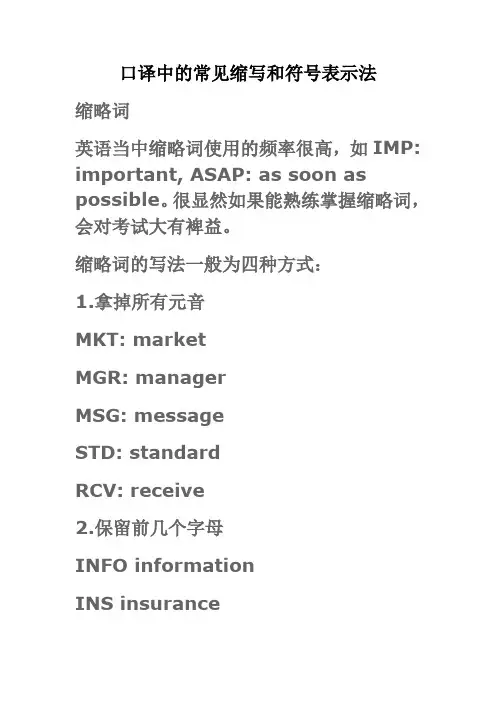
口译中的常见缩写和符号表示法缩略词英语当中缩略词使用的频率很高,如IMP: important, ASAP: as soon as possible。
很显然如果能熟练掌握缩略词,会对考试大有裨益。
缩略词的写法一般为四种方式:1.拿掉所有元音MKT: marketMGR: managerMSG: messageSTD: standardRCV: receive2.保留前几个字母INFO informationINS insuranceEXCH exchangeI owe you IOUIn stead of I/O3.保留开头和结尾的发音字母WK weekRM roomPL people4.根据发音R areTHO thoughTHRU through高级口译听力常用英语缩略词表缩略词原词APT ApartmentACC AccountantACDG AccordingACPT AcceptAD AdvertisementADS AddressADV AdviceAMAP As much/many as possible AMT AmountAPV ApproveASAP As soon as possibleBAL BalanceBLDG BuildingCERT CertificateCFM ConformCNCL CancelCNF ConferenceCMI CommissionCMP CompleteCMPE Compete/competitive CMU CommunicationCONCConcern/concerning/concerned COND ConditionCO. CompanyDEPT DepartmentDISC DiscountDPT DepartureEXCH ExchangeEXPLN ExplainEXT ExtentFLT FlightFNT FinalFRT FreightFYR For your reference GD GoodGUAR GuaranteeH.O. Home officeINFO Information IMPS ImpossibleIMP(T) Important INCD IncludeINDIV IndividualINS InsuranceINTST InterestedI/O In stead ofIOU I owe youIVO In view ofMANUF Manufacture MDL ModelMEMO Memorandum MGR MangerMIN MinimumMKT MarketMSG Message NCRY Necessary NLT No later than OBS ObserveOBT ObtainORD OrdinaryPAT PatentPC PiecePKG PackingPL PeoplePLS PleasePOSN Position POSS(BL) Possible PROD ProductQLTY QualityQUTY QuantityRCV ReceiveREF Reference REGL RegularREP Representative RESN Reservation RPT Repeat RESPON Responsible SEC SectionSITN Situation STD Standard TEL Telephone TEMP Temporary TGM Telegraph THO Though TKS ThanksTRD TradeTRF TrafficTTL TotalU YouUR YourWK WeekWL WillWT WeightXL Extra large字母、图像Z 表示“人” people/person,因为Z 看上去像个人头,它通常被写在一个词或符号的右上角。
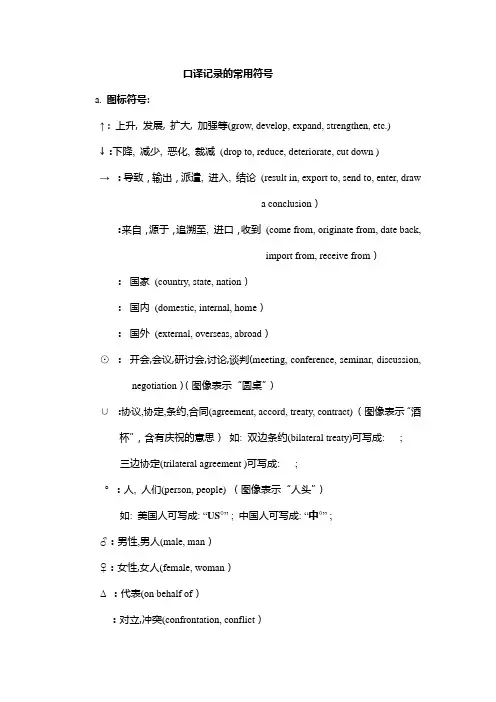
口译记录的常用符号a.图标符号:↑ : 上升, 发展, 扩大, 加强等(grow, develop, expand, strengthen, etc.)↓ :下降, 减少, 恶化, 裁减(drop to, reduce, deteriorate, cut down )→ :导致,输出,派遣, 进入, 结论(result in, export to, send to, enter, drawa conclusion):来自,源于,追溯至, 进口,收到(come from, originate from, date back,import from, receive from):国家(country, state, nation):国内(domestic, internal, home):国外(external, overseas, abroad)⊙:开会,会议,研讨会,讨论,谈判(meeting, conference, seminar, discussion, negotiation)(图像表示“圆桌”)∪:协议,协定,条约,合同(agreement, accord, treaty, contract) (图像表示“酒杯”,含有庆祝的意思)如: 双边条约(bilateral treaty)可写成: ;三边协定(trilateral agreement )可写成: ;°:人, 人们(person, people) (图像表示“人头”)如: 美国人可写成: “US°” ; 中国人可写成: “中°” ;♂:男性,男人(male, man)♀:女性,女人(female, woman)Δ:代表(on behalf of):对立,冲突(confrontation, conflict)~ :交流,交换, 相互(exchange, replace, each other)?:疑问,问题,提问(doubt , problem, question, ask): :说,告诉,认为,声明,例如(say, speak, tell, think, declare, such as, like)( ):包括,在…之中/内,封闭(including, within, among, inside, seclusion)∈:属于,归于,归属(belong to ,be part of, fall into, pertain to)// :停顿,停止,终止(stop, halt)& :和,与…一起(and, together with)…:等等(and so on, and so forth, and the like, etc.)√:正确,好,肯定的,积极的,同意(correct, good, affirmative, certain, positive, agree)×:不/非,错误的,坏的,不好的, 否定的(not, no, wrong, incorrect, bad, notorious, negative)☆:杰出的,优秀的,最佳的,重要的,榜样(outstanding, excellent, best, important, model)(星光璀璨,表示“优秀,突出”):高兴,开心,愉快,兴奋(happy, pleased, delightful, joyful, excited)(这是个脸谱图像符号,嘴巴向上翘,表示“开心”):不满,生气,不开心,郁闷(unsatisfied, angry, unhappy, gloomy)(嘴巴向下撇,表示“不高兴”):惊讶,惊奇,吃惊,震惊(surprised , astonished , amazed, shocked )(嘴巴张大,表示“吃惊”):害怕,恐惧,恐慌(scared , frightened, panic ) (两只眼睛张大,表示“恐惧”):听说,据说,众所周知(it is said that, maybe you’ve heard of, as we allknow , as is known to all ) (脑袋上画个耳朵,表示“听说过,有所闻”)b .数学符号:= :等于,相当于,是…的对手(equal to, the same as, a match/rival/competitor for sb.)≠:不等于,不同,不是…的对手(not equal to, different, no match for)≈:大约,左右(approximately, around, or so )>:大于,多于,超过,优于(greater, larger or more than, better than, surpass, superior to)<:小于,少于,不够,劣于,次于(smaller/fewer/less than, worse than, inferior to)+ :加上,另外,除此之外(plus, add, moreover, besides, in addition to, furthermore)-:减去,扣除,缺乏(minus, deduct, lack )∑:总共,合计(total, in all, add up )% :百分比,百分之…(percent)‰:千分比,千分之…(per thousand)∵:因为, 由于(as, because, owing to, due to, thanks to)∴:所以, 因此, 因而(consequently, so, therefore, as a result)c .常用缩写词:UN ( United Nations ) :联合国UNESCO (United Nations Educational, Scientific and Cultural Organization):联合国教科文组织UNICEF (United Nations International Children's Emergency Fund):联合国儿童基金会UNHCR (United Nations High Commissioner for Refugees):联合国难民公署EU (European Union ) : 欧洲联盟(简称“欧盟”)EEC (European Economic Community): 欧洲经济共同体NATO (North Atlantic Treaty Organization): 北大西洋公约组织APEC (Asian Pacific Economic Cooperation): 亚太经济合作组织WTO (World Trade Organization): 世界贸易组织WB (World Bank): 世界银行IMF(International Monetary Fund):国际货币基金组织L.G( ladies and gentlemen):女士们、先生们TKS( thanks):谢谢Org(organization):组织Co.(Company):公司MKT(market):市场L/C(letter of credit):信用证Ltd.(Limited): 有限Memo (memorandum): 备忘录 B.C.(before Christ): 公元前e. g. (for example): 例如i.e. (that is ): 即;那就是etc. (and so on ):等等esp.(especially):特别;尤其usu.(usually):通常;惯常max.(maximum): 最高min.(minimum): 最低;最小Wt.(weight):重量Kg.(kilogramme):公斤;千克b. (billion ): 十亿m.(million, meter, mile):百万;米;英里t.( thousand ,temperature , ton):千; 温度; 吨h. (hundred, hour, height): 百;小时;高度km. (kilometer)千米:公里sq. km (square kilometer):平方公里E(East):东S( South):南W( West ):西N( North ):北Q.( question ) :问题; A.(answer, acre ): 回答;英亩C (centigrade): 摄氏温度F( Fahrenheit): 华氏温度att. (attention):注意cf.(compare):比较c/o(care of): 转交ref.(reference):参考add.(Address):住址st.(street): 街std.(standard): 标准econ. (economy):经济ad.(advertisement):广告w (world):世界p (peace):和平r (repetition):重复y (year):年m (month):月w (week):星期 d (day):日a.m.(before noon):上午p.m.(afternoon):下午CN(China):中国(或简写为“中”) US(United States ):美国F(France):法国J(Japan):日本(或简写为“日”) UK(United Kingdom):英国HK(Hong Kong):香港MO(Macao):澳门TW(Taiwan):台湾AL(Australia ):澳大利亚SD(Sweden):瑞典SZ(Switzerland):瑞士CIS (Commonwealth of Independent States):独联体IQ(Iraq):伊拉克IR(Iran):伊朗ID(India):印度IN(Indonesia):印度尼西亚PL(Palestine ):巴勒斯坦PK(Pakistan):巴基斯坦d .综合性符号:. d ( yesterday): 昨天.. d (the day before yesterday): 前天. y( last year): 去年.. y (the year before last ): 前年d . (tomorrow): 明天 d .. (the day after tomorrow): 后天y . (next year): 明年y .. (the year after last): 后天[注:在年、月、日缩写词前后加“.” , 表示时间的推前或后移。
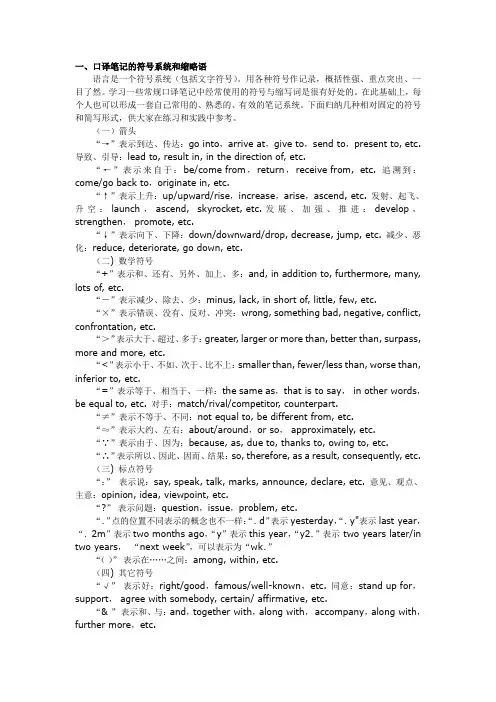
一、口译笔记的符号系统和缩略语语言是一个符号系统(包括文字符号)。
用各种符号作记录,概括性强、重点突出、一目了然。
学习一些常规口译笔记中经常使用的符号与缩写词是很有好处的。
在此基础上,每个人也可以形成一套自己常用的、熟悉的、有效的笔记系统。
下面归纳几种相对固定的符号和简写形式,供大家在练习和实践中参考。
(一)箭头“→”表示到达、传达:go into,arrive at,give to,send to,present to, etc. 导致、引导:lead to, result in, in the direction of, etc.“←”表示来自于:be/come from,return,receive from, etc. 追溯到:come/go back to,originate in, etc.“↑”表示上升:up/upward/rise,increase,arise,ascend, etc. 发射、起飞、升空:launch,ascend, skyrocket, etc.发展、加强、推进:develop,strengthen, promote, etc.“↓”表示向下、下降:down/downward/drop, decrease, jump, etc. 减少、恶化:reduce, deteriorate, go down, etc.(二) 数学符号“+”表示和、还有、另外、加上、多:and, in addition to, furthermore, many, lots of, etc.“-”表示减少、除去、少:minus, lack, in short of, little, few, etc.“×”表示错误、没有、反对、冲突:wrong, something bad, negative, conflict, confrontation, etc.“>”表示大于、超过、多于:greater, larger or more than, better than, surpass, more and more, etc.“<”表示小于、不如、次于、比不上:smaller than, fewer/less than, worse than, inferior to, etc.“=”表示等于、相当于、一样:the same as,that is to say, in other words,be equal to, etc. 对手:match/rival/competitor, counterpart.“≠”表示不等于、不同:not equal to, be different from, etc.“≈”表示大约、左右:about/around,or so, approximately, etc.“∵”表示由于、因为:because, as, due to, thanks to, owing to, etc.“∴”表示所以、因此、因而、结果:so, therefore, as a result, consequently, etc.(三) 标点符号“:”表示说:say, speak, talk, marks, announce, declare, etc. 意见、观点、主意:opinion, idea, viewpoint, etc.“?”表示问题:question,issue,problem, etc.“.”点的位置不同表示的概念也不一样:“.d”表示yesterday,“.y"表示last year,“.2m”表示two months ago,“y”表示this year,“y2.”表示 two years later/in two years,“next week”,可以表示为“wk.”“()”表示在……之间:among, within, etc.(四) 其它符号“√”表示好:right/good,famous/well-known,etc. 同意:stand up for,support, agree with somebody, certain/ affirmative, etc.“& ”表示和、与:and,together with,along with, accompany,along with,further more,etc.“☆”表示重要的、杰出的、优秀的、榜样:important, best,outstanding,brilliant,model, etc.“∥”表示结束:end,stop,halt,bring something to a standstill/stop, etc.“°”表示人、者:person, people, 如经济学家可以表示为“经°”,中国人可以表示为“中°”,etc.“⊙”表示会议、讨论、谈判:meeting, seminar, discussion, negotiation, etc.“♂”表示男人:man, male, boy, etc.“♀”表示女人:woman, female, girl, etc.“□”表示国家:country, state, nation, etc.“△”表示代表:represent, on behalf of, etc.“∽”表示交流、交换、替代、相互:exchange, mutual, each other, communication, replace, etc.(五) 缩略词英语缩写词的写法一般有以下几种:●拿掉所有元音。
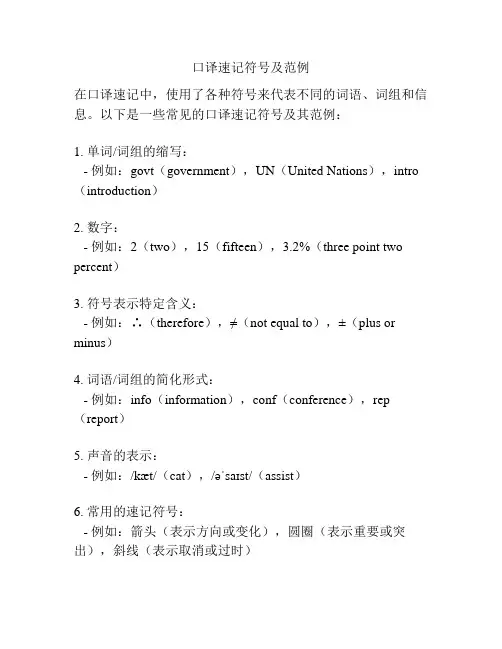
口译速记符号及范例
在口译速记中,使用了各种符号来代表不同的词语、词组和信息。
以下是一些常见的口译速记符号及其范例:
1. 单词/词组的缩写:
- 例如:govt(government),UN(United Nations),intro (introduction)
2. 数字:
- 例如:2(two),15(fifteen),3.2%(three point two percent)
3. 符号表示特定含义:
- 例如:∴(therefore),≠(not equal to),±(plus or minus)
4. 词语/词组的简化形式:
- 例如:info(information),conf(conference),rep (report)
5. 声音的表示:
- 例如:/kæt/(cat),/əˈsaɪst/(assist)
6. 常用的速记符号:
- 例如:箭头(表示方向或变化),圆圈(表示重要或突出),斜线(表示取消或过时)
7. 符号的组合和结构:
- 例如:↑(上升),↓(下降),→(发展),←(反对)
8. 表示固定短语或俚语的符号:
- 例如:BFF(best friends forever),TGIF(Thank God it's Friday)
请注意,以上仅为一些常见的例子,实际上口译速记符号有很多种,各口译员可能会根据个人习惯和需求进行一些定制或修改。
使用哪些符号以及如何使用符号,都取决于个人风格和技巧。
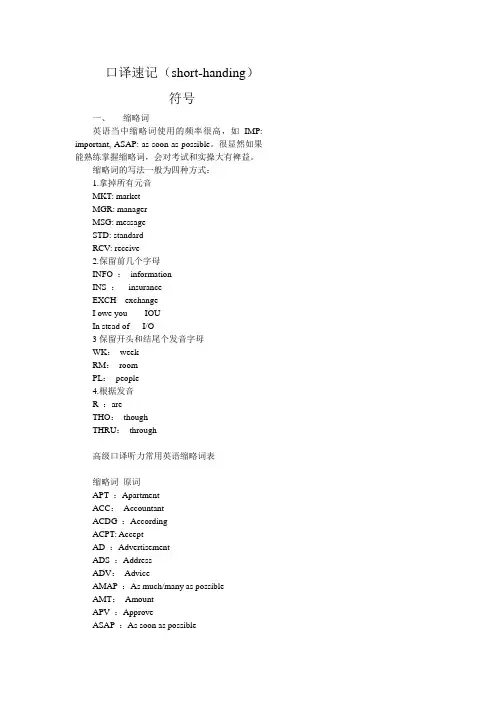
口译速记(short-handing)符号一、缩略词英语当中缩略词使用的频率很高,如IMP: important, ASAP: as soon as possible。
很显然如果能熟练掌握缩略词,会对考试和实操大有裨益。
缩略词的写法一般为四种方式:1.拿掉所有元音MKT: marketMGR: managerMSG: messageSTD: standardRCV: receive2.保留前几个字母INFO :informationINS :insuranceEXCH exchangeI owe you IOUIn stead of I/O3保留开头和结尾个发音字母WK:weekRM:roomPL:people4.根据发音R :areTHO:thoughTHRU:through高级口译听力常用英语缩略词表缩略词原词APT :ApartmentACC:AccountantACDG :AccordingACPT: AcceptAD :AdvertisementADS :AddressADV:AdviceAMAP :As much/many as possibleAMT:AmountAPV :ApproveASAP :As soon as possibleBLDG :BuildingCERT CertificateCFM :ConformCNCL :CancelCNF:ConferenceCMI :CommissionCMP :CompleteCMPE :Compete/competitiveCMU :CommunicationCONC :Concern/concerning/concerned COND :ConditionCO. :CompanyDEPT:DepartmentDISC :DisqueEXCH:ExchangeEXPLN:ExplainEXT:ExtentFLT :FinalFRT:FreightFYR :For your referenceGD :GoodGUAR :GuaranteeH.O. Home officeINFO :InformationIMPS :ImpossibleIMP(T):ImportantINCD :IncludeINDIV :IndividualINS:InsuranceINTST :InterestedI/O :In stead ofIOU :I owe youIVO:In view ofMANUF :ManufactureMDL :ModelMEMO :MemorandumMGR :MangerMIN :MinimumMKT :MarketMSG :MessageNCRY :NecessaryNLT :No later thanOBS :ObserveORD :OrdinaryPAT :PatentPC :PiecePKG :PackingPL :PeoplePLS :PleasePOSN:PositionPOSS(BL):PossiblePROD:ProductQLTY:QualityQUTY:QuantityRCV:ReceiveREF :ReferenceREGL :RegularREP :RepresentativeRESN:ReservationRPT :RepeatRESPON :ResponsibleSEC:SectionSITN :SituationSTD :StandardTEL :TelephoneTEMP :TemporaryTGM :TelegraphTHO :ThoughTKS :ThanksTRD :TradeTRF:TrafficTTL :TotalU :YouUR :YourWK :WeekWL :WillWT :WeightXL:Extra large二、字母、图像Z 表示"人"people/person,因为"Z"看上去像个人头,它通常被写在一个词或符号的右上角。
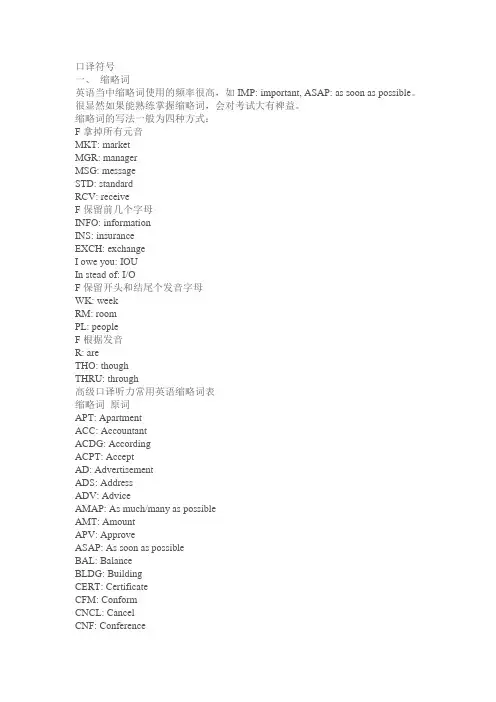
口译符号一、缩略词英语当中缩略词使用的频率很高,如IMP: important, ASAP: as soon as possible。
很显然如果能熟练掌握缩略词,会对考试大有裨益。
缩略词的写法一般为四种方式:F拿掉所有元音MKT: marketMGR: managerMSG: messageSTD: standardRCV: receiveF保留前几个字母INFO: informationINS: insuranceEXCH: exchangeI owe you: IOUIn stead of: I/OF保留开头和结尾个发音字母WK: weekRM: roomPL: peopleF根据发音R: areTHO: thoughTHRU: through高级口译听力常用英语缩略词表缩略词原词APT: ApartmentACC: AccountantACDG: AccordingACPT: AcceptAD: AdvertisementADS: AddressADV: AdviceAMAP: As much/many as possibleAMT: AmountAPV: ApproveASAP: As soon as possibleBAL: BalanceBLDG: BuildingCERT: CertificateCFM: ConformCNCL: CancelCNF: ConferenceCMI: CommissionCMP: CompleteCMPE: Compete/competitiveCMU: CommunicationCONC: Concern/concerning/concerned COND: ConditionCO.: CompanyDEPT: DepartmentDISC: DiscountDPT: DepartureEXCH: ExchangeEXPLN: ExplainEXT: ExtentFLT: FlightFNT: FinalFRT: FreightFYR: For your referenceGD: GoodGUAR: GuaranteeH.O.: Home officeINFO: InformationIMPS: ImpossibleIMP(T): ImportantINCD: IncludeINDIV: IndividualINS: InsuranceINTST: InterestedI/O: In stead ofIOU: I owe youIVO: In view ofMANUF: ManufactureMDL: ModelMEMO: MemorandumMGR: MangerMIN: MinimumMKT: MarketMSG: MessageNCRY: NecessaryNLT: No later thanOBS: ObserveOBT: ObtainORD: OrdinaryPAT: PatentPC: PiecePKG: PackingPL: PeoplePLS: PleasePOSN: PositionPOSS(BL): PossiblePROD: ProductQLTY: QualityQUTY: Quantity二、字母、图像Z 表示"人"people/person,因为"Z"看上去像个人头,它通常被写在一个词或符号的右上角。
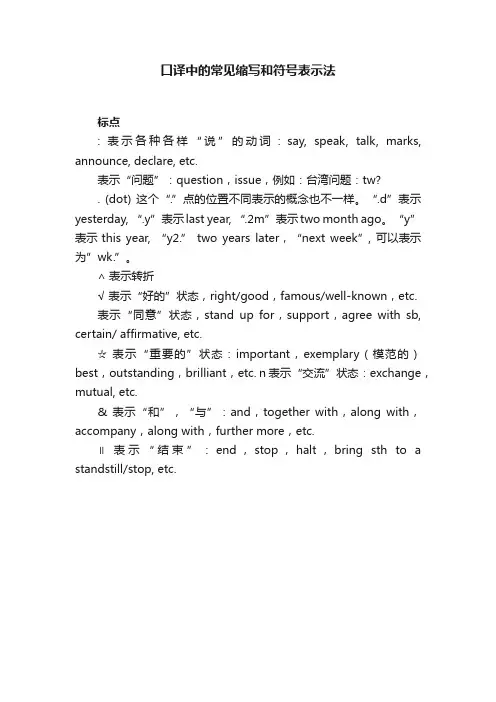
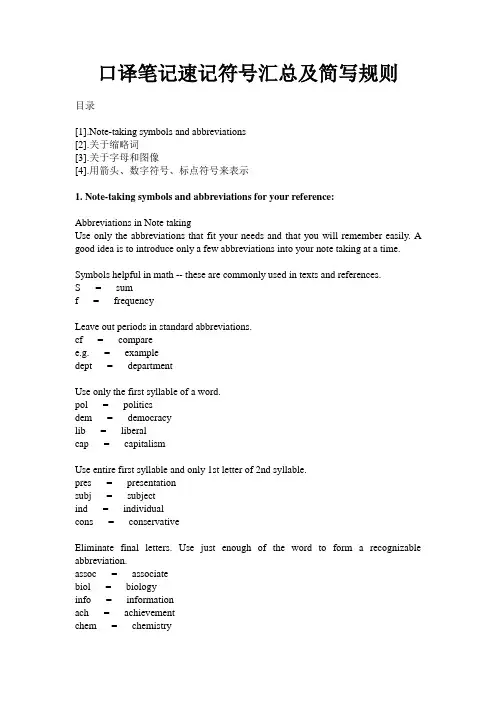
口译笔记速记符号汇总及简写规则目录[1].Note-taking symbols and abbreviations[2].关于缩略词[3].关于字母和图像[4].用箭头、数字符号、标点符号来表示1. Note-taking symbols and abbreviations for your reference:Abbreviations in Note takingUse only the abbreviations that fit your needs and that you will remember easily. A good idea is to introduce only a few abbreviations into your note taking at a time. Symbols helpful in math -- these are commonly used in texts and references.S = sumf = frequencyLeave out periods in standard abbreviations.cf = comparee.g. = exampledept = departmentUse only the first syllable of a word.pol = politicsdem = democracylib = liberalcap = capitalismUse entire first syllable and only 1st letter of 2nd syllable.pres = presentationsubj = subjectind = individualcons = conservativeEliminate final letters. Use just enough of the word to form a recognizable abbreviation.assoc = associatebiol = biologyinfo = informationach = achievementchem = chemistrymax = maximumintro = introductionconc = concentrationmin = minimumrep = repetitionOmit vowels, retain only enough consonants to give a recognizable skeleton of the word.ppd = preparedprblm = problemestmt = estimatebkgd = backgroundgvt = governmentUse an apostrophe in place of letters.am't = amountcont'd = continuedgov't = governmenteducat'l = educationalForm the plural of a symbol or abbreviated word by adding s.chpts = chaptersegs = examplesfs = frequenciesintros = introductionsUse g to represent ing endings.ckg = checkingestg = establishingdecrg = decreasingexptg = experimentingSpell out short words such as in, at, to, but, for, and key.Abbreviations or symbols for short words will make the notes too dense with shorthand.Leave out unimportant words.Leave out the words a and the.If a term, phrase, or name is written out in full during the lecture, substitute initials whenever the term, phrase, or name is used again. For example, Center for Aerospace Sciences becomes CAS thereafter.Use symbols for commonly recurring connective or transitional words.& = andw/ = withw/o = withoutvs = against\ = therefore= = is or equalUse technical symbols where applicable.zb = German, for exampleibid = Latin, the same worko = degreesH2O = waterMore reference:Use standard maths, accounting, and science symbols. Examples:+ plus// parallelUse standard abbreviations and leave out full stops. Examples:eg exampleIT dept Information Technology departmentUK United KingdomUse only the first syllable of a word. Examples:mar marketingcus customercli clientUse the entire first syllable and the first letter of the second syllable. Examples:subj subjectbudg budgetind individualTo distinguish among various forms of the same word, use the first syllable of the word, an apostrophe, and the ending of the word. Examples:tech'gy technologygen'ion generalisationdel'y deliveryUse just enough of the beginning of a word to form a recognisable abbreviation. Examples:assoc associatedach achievementinfo informationOmit vowels from the middle of words, retaining only enough consonants to provide a recognisable skeleton of the word. Examples:bkgd backgroundmvmt movementprblm problemForm the plural of a symbol or abbreviated word by adding 's.' Examples:custs customersfs frequencies/s ratiosUse 'g' to represent 'ing' endings. Examples:decrg decreasingckg checkingestblg establishingSpell out, rather than abbreviate short words. Examples:inbutaskeyLeave out unimportant verbs. Examples:iswaswereLeave out unnecessary articles. Examples:aantheIf a term, phrase, or name is initially written out in full during the talk or meeting, initials can be substituted whenever the term, phrase, or name is used again. Example: January Advertising Campaign Budget JACBUse symbols for common connective or transition words. Examples:@ at2 to4 for& andw/ withw/o withoutvs againstCreate your own set of abbreviations and symbols. You may wish to develop separate sets of symbols and abbreviations for different courses or subjects.Other Symbols and Abbreviationsas a result of / consequences of <--->resulting in --->and / also +equal to / same as =following ffmost importantly *less than <greater than > especially esp/一、缩略词英语当中缩略词使用的频率很高,如IMP: important, ASAP: as soon as possible。
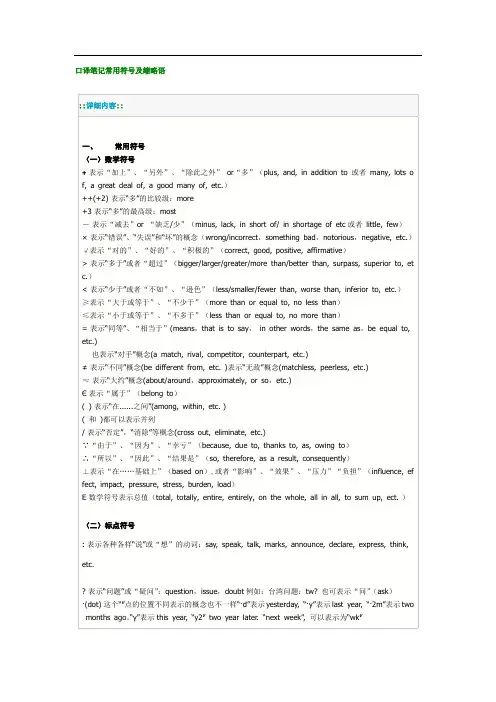
口译笔记常用符号及缩略语::详细内容::一、常用符号(一)数学符号+表示“加上”、“另外”、“除此之外”or“多”(plus, and, in addition to 或者many, lots o f, a great deal of, a good many of, etc.)++(+2) 表示“多”的比较级:more+3 表示“多”的最高级:most-表示“减去”or “缺乏/少”(minus, lack, in short of/ in shortage of etc或者little, few)×表示“错误”、“失误”和“坏”的概念(wrong/incorrect,something bad,notorious,negative, etc.)√表示“对的”、“好的”、“积极的”(correct, good, positive, affirmative)> 表示“多于”或者“超过”(bigger/larger/greater/more than/better than, surpass, superior to, et c.)< 表示“少于”或者“不如”、“逊色”(less/smaller/fewer than, worse than, inferior to, etc.)≥表示“大于或等于”、“不少于”(more than or equal to, no less than)≤表示“小于或等于”、“不多于”(less than or equal to, no more than)= 表示“同等”、“相当于”(means,that is to say,in other words,the same as,be equal to, etc.)也表示“对手”概念(a match, rival, competitor, counterpart, etc.)≠表示“不同”概念(be different from, etc. )表示“无敌”概念(matchless, peerless, etc.)≈表示“大约”概念(about/around,approximately, or so,etc.)Є表示“属于”(belong to)( ) 表示“在......之间”(among, within, etc. )( 和)都可以表示并列/ 表示“否定”,“消除”等概念(cross out, eliminate, etc.)∵“由于”、“因为”、“幸亏”(because, due to, thanks to, as, owing to)∴“所以”、“因此”、“结果是”(so, therefore, as a result, consequently)⊥表示“在……基础上”(based on),或者“影响”、“效果”、“压力”“负担”(influence, ef fect, impact, pressure, stress, burden, load)E 数学符号表示总值(total, totally, entire, entirely, on the whole, all in all, to sum up, ect. )(二)标点符号: 表示各种各样“说”或“想”的动词:say, speak, talk, marks, announce, declare, express, think, etc.表示“问题”或“疑问”:question,issue,doubt例如:台湾问题:tw? 也可表示“问”(ask)·(dot) 这个“·”点的位置不同表示的概念也不一样“·d”表示yesterday, “·y”表示last year, “·2m”表示two months ago。
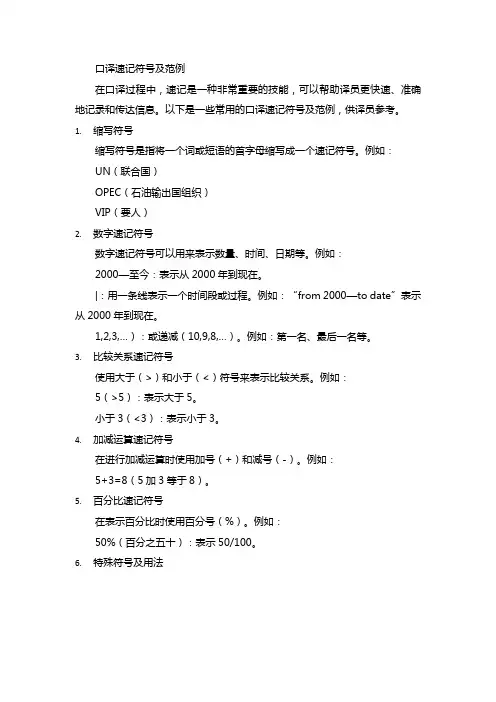
口译速记符号及范例
在口译过程中,速记是一种非常重要的技能,可以帮助译员更快速、准确地记录和传达信息。
以下是一些常用的口译速记符号及范例,供译员参考。
1.缩写符号
缩写符号是指将一个词或短语的首字母缩写成一个速记符号。
例如:
UN(联合国)
OPEC(石油输出国组织)
VIP(要人)
2.数字速记符号
数字速记符号可以用来表示数量、时间、日期等。
例如:
2000—至今:表示从2000年到现在。
|:用一条线表示一个时间段或过程。
例如:“from 2000—to date”表示从2000年到现在。
1,2,3,…):或递减(10,9,8,…)。
例如:第一名、最后一名等。
3.比较关系速记符号
使用大于(>)和小于(<)符号来表示比较关系。
例如:
5(>5):表示大于5。
小于3(<3):表示小于3。
4.加减运算速记符号
在进行加减运算时使用加号(+)和减号(-)。
例如:
5+3=8(5加3等于8)。
5.百分比速记符号
在表示百分比时使用百分号(%)。
例如:
50%(百分之五十):表示50/100。
6.特殊符号及用法。
口译常用的笔记符号汇总一、前言口译笔记是一种有效的辅助工具,能够帮助译员记录关键信息,提高翻译的准确性和效率。
正确的笔记可以帮助译员在紧张的口译环境中保持清晰思维,避免因遗忘或疏忽而造成的错误。
本篇文档旨在汇总口译过程中常用的笔记符号,以便译员在实践中参考和使用。
二、笔记符号说明1.缩写词:用字母、数字等简洁形式记录单词或短语,如“u”代表“under”,“m”代表“meeting”。
2.符号:用各种符号记录概念、观点、人名等,如“△”代表“注意”,“☆”代表“重要”。
3.符号组合:将多个符号组合使用,表达更复杂的含义,如“⊙”+“b”+“√”代表“乙方已确认”。
4.线条:用线条记录时间和空间信息,如“↑”代表时间推进,“●”代表地点。
5.特殊符号:用特殊符号记录特殊概念或情况,如“*”代表突发情况,“#”代表需要特别关注的人或事。
6.标注:在单词、短语或句子旁边添加注释,如“注意语法”、“需要核实信息”。
三、笔记符号分类1.词汇类:包括名词、动词、形容词、副词等基本词汇的记录,如“公司”、“讨论”、“热情”、“快速”。
2.句式类:包括常用句型、表达方式、习惯用语的记录,如“如果…就…”,“预期效果是…”。
3.人名地名类:包括人名、地名等专有名词的记录,如“张三”、“北京”、“上海”。
4.特殊符号类:包括数字、货币、度量衡等特殊概念的记录,如“100元”,“50公斤”。
5.时间空间类:包括时间、日期、星期、月份、季节、天气等空间信息的记录,如“今天星期四”,“会议在会议室进行”。
四、常见笔记符号示例1.缩写词示例:“d=day,n=night,e=email”2.符号示例:“▲=减慢速度,●=暂停”,“※=重要信息”,“$=货币符号”,“※+手+√=手记确认”3.符号组合示例:“※+笔+√=需要记录的信息”,“●+椅子+√=休息地点”4.标注示例:“√=已同意”,“?=需要进一步确认”,“↑=增加音量”,“↓=降低音量”5.时间空间示例:“↑9:00”,“↓会议室”,“#主席台”五、总结口译过程中,正确的笔记可以帮助译员快速记录关键信息,提高翻译效率。
口译符号一、缩略词英语当中缩略词使用的频率很高,如IMP: important, ASAP: as soon as possible。
缩略词的写法一般为四种方式:拿掉所有元音MKT: market MGR: manager MSG: messageSTD: standard RCV: receive保留前几个字母INFO information INS insurance EXCH exchangeIOU I owe you I/O In stead of保留开头和结尾个发音字母WK week RM room PL people根据发音R are THO though THRU through高级口译听力常用英语缩略词表二、字母、图像1. Z 表示"人"people/person,因为"Z"看上去像个人头,它通常被写在一个词或符号的右上角。
例如:日本人:JZ。
2. C 表示政府,统治:government,govern 希腊字母C读/ga:ma/,近似government, 所以就用C来表示govern, government。
governmental official 可以表示为CZ3. P 表示政治:politics, political希腊字母P读/pai/,近似politics, political。
那么politician就可以表示为PZ4. E 表示总数:total, totally, entire, entirely, on the whole, all in all, to sum up, ect. E 数学符号表示总值。
5. G 表示效率:efficient, effective。
G为效率符号。
6. Q 表示"通货膨胀":inflation因为这个符号酷似一个上升的气球。
7. A 表示农业: agriculture. agriculture经常用到,所以用首字母代替。
口译笔译符号及方法(转)一、缩略词英语当中缩略词使用的频率很高,如IMP: important, ASAP: as soon as possible。
很显然如果能熟练掌握缩略词,会对考试大有裨益。
缩略词的写法一般为四种方式:F拿掉所有元音MKT: marketMGR: managerMSG: messageSTD: standardRCV: receiveF保留前几个字母INFO informationINS insuranceEXCH exchangeI owe you IOUIn stead of I/OF保留开头和结尾个发音字母WK weekRM roomPL peopleF根据发音R areTHO thoughTHRU through高级口译听力常用英语缩略词表缩略词原词APT ApartmentACCAccountantACDG AccordingACPT AcceptAD AdvertisementADS AddressADV AdviceAMAP As much/many as possibleAMT AmountAPV ApproveASAP As soon as possibleBAL BalanceBLDG BuildingCERT CertificateCFM ConformCNCL CancelCNF ConferenceCMI CommissionCMP CompleteCMPE Compete/competitiveCMU CommunicationCONC Concern/concerning/concerned COND ConditionCO. CompanyDEPT DepartmentDISC DiscountDPT DepartureEXCH ExchangeEXPLN ExplainEXT ExtentFLT FlightFNT FinalFRT FreightFYR For your referenceGD GoodGUAR GuaranteeH.O. Home officeINFO InformationIMPS ImpossibleIMP(T) ImportantINCD IncludeINDIV IndividualINS InsuranceINTST InterestedI/O In stead ofIOU I owe youIVO In view ofMANUF ManufactureMDL ModelMEMO MemorandumMGR MangerMIN MinimumMKT MarketMSG MessageNCRY NecessaryNLT No later thanOBS ObserveOBT ObtainORD OrdinaryPAT PatentPC PiecePKG PackingPL PeoplePLS PleasePOSN PositionPOSS(BL) PossiblePROD ProductQLTY QualityQUTY QuantityRCV ReceiveREF ReferenceREGL RegularREP RepresentativeRESN ReservationRPT RepeatRESPON ResponsibleSEC SectionSITN SituationSTD StandardTEL TelephoneTEMP TemporaryTGM TelegraphTHO ThoughTKS ThanksTRD TradeTRF TrafficTTL TotalU YouUR YourWK WeekWL WillWT WeightXL Extra large二、二、字母、图像Z 表示"人"people/person,因为"Z"看上去像个人头,它通常被写在一个词或符号的右上角。
口译笔记符号大全
口译笔记符号没有统一的标准,以下是一些常见的口译笔记符号:
1. 阿拉伯数字:用来表示数量或者时间。
例如:3表示三;20表示二十。
2. 英文字母:用来表示人名、地名、机构名等专有名词。
例如:USA表示
美国;UN表示联合国。
3. 汉字简化:用来表示中文词汇,简化后的字更容易书写和记忆。
例如:资表示资源;产表示产业。
4. 符号:用来表示某种含义或者概念。
例如:↑表示增加;↓表示减少;→表示导致;←表示源于。
5. 图形:用来表示某种形状或者结构。
例如:方形表示矩形;圆形表示圆形;三角形表示三角形。
这些符号可以根据个人的习惯和需要进行选择和调整,最重要的是自己能够理解和记忆。
口译笔译符号缩略词缩略词的写法一般为四种方式:F拿掉所有元音MKT: marketMGR: managerMSG: messageSTD: standardRCV: receiveF保留前几个字母INFO informationINS insuranceEXCH exchangeI owe you IOUIn stead of I/OF保留开头和结尾个发音字母WK weekRM roomPL peopleF根据发音R areTHO thoughTHRU through高级口译听力常用英语缩略词表缩略词原词APT ApartmentACC AccountantACDG AccordingACPT AcceptAD AdvertisementADS AddressADV AdviceAMAP As much/many as possible AMT AmountAPV ApproveASAP As soon as possibleBAL BalanceBLDG BuildingCERT CertificateCFM ConformCNCL CancelCNF ConferenceCMI CommissionCMP CompleteCMPE Compete/competitiveCMU CommunicationCONC Concern/concerning/concerned COND ConditionCO. CompanyDEPT DepartmentDISC DiscountDPT DepartureEXCH ExchangeEXPLN ExplainEXT ExtentFLT FlightFNT FinalFRT FreightFYR For your referenceGD GoodGUAR GuaranteeH.O. Home officeINFO InformationIMPS ImpossibleIMP(T) ImportantINCD IncludeINDIV IndividualINS InsuranceINTST InterestedI/O In stead ofIOU I owe youIVO In view ofMANUF ManufactureMDL ModelMEMO MemorandumMGR MangerMIN MinimumMKT MarketMSG MessageNCRY NecessaryNLT No later thanOBS ObserveOBT ObtainORD OrdinaryPAT PatentPC PiecePKG PackingPL PeoplePLS PleasePOSN PositionPOSS(BL) PossiblePROD ProductQLTY QualityQUTY QuantityRCV ReceiveREF ReferenceREGL RegularREP RepresentativeRESN ReservationRPT RepeatRESPON ResponsibleSEC SectionSITN SituationSTD StandardTEL TelephoneTEMP TemporaryTGM TelegraphTHO ThoughTKS ThanksTRD TradeTRF TrafficTTL TotalU YouUR YourWK WeekWL WillWT WeightXL Extra large二、二、字母、图像Z 表示"人"people/person,因为"Z"看上去像个人头,它通常被写在一个词或符号的右上角。
考试中要牢记的口译符号一、缩略词英语当中缩略词使用的频率很高,如IMP: important, ASAP: as soon as possible。
很显然如果能熟练掌握缩略词,会对有裨益。
缩略词的写法一般为四种方式:F拿掉所有元音MKT: marketMGR: managerMSG: messageSTD: standardRCV: receiveF保留前几个字母INFO: informationINS: insuranceEXCH: exchangeI owe you: IOUIn stead of: I/OF保留开头和结尾个发音字母WK: weekRM: roomPL: peopleF根据发音R: areTHO: thoughTHRU: through高级口译听力常用英语缩略词表缩略词原词APT: ApartmentACC: AccountantACDG: AccordingACPT: AcceptAD: AdvertisementADS: AddressADV: AdviceAMAP: As much/many as possibleAMT: AmountAPV: ApproveASAP: As soon as possibleBAL: BalanceBLDG: BuildingCERT: CertificateCFM: ConformCNCL: CancelCNF: ConferenceCMI: CommissionCMP: CompleteCMPE: Compete/competitiveCMU: CommunicationCONC: Concern/concerning/concernedCOND: ConditionCO.: CompanyDEPT: DepartmentDISC: DiscountDPT: DepartureEXCH: ExchangeEXPLN: ExplainEXT: ExtentFLT: FlightFNT: FinalFRT: FreightFYR: For your referenceGD: GoodGUAR: GuaranteeH.O.: Home officeINFO: InformationIMPS: ImpossibleIMP(T): ImportantINCD: IncludeINDIV: IndividualINS: InsuranceINTST: InterestedI/O: In stead ofIOU: I owe youIVO: In view ofMANUF: ManufactureMDL: ModelMEMO: MemorandumMGR: MangerMIN: MinimumMKT: MarketMSG: Message NCRY: Necessary PAT: PatentNLT: No later than OBS: Observe OBT: Obtain ORD: ordinary PC: Piece PKG: Packing PL: People PLS: Please POSN: Position POSS(BL): Possible PROD: Product QLTY: QualityQUTY: Quantity二、字母、图像Z 表示"人"people/person,因为"Z"看上去像个人头,它通常被写在一个词或符号的右上角。
口译中的常见缩写和符号表示法缩略词英语当中缩略词使用的频率很高,如IMP: important, ASAP: as soon as possible。
很显然如果能熟练掌握缩略词,会对考试大有裨益。
缩略词的写法一般为四种方式:1.拿掉所有元音MKT: market MGR: manager MSG: messageSTD: standard RCV: receive2.保留前几个字母INFO information INS insurance EXCH exchangeI owe you IOU In stead of I/O3.保留开头和结尾的发音字母WK week RM room PL people4.根据发音R are THO though THRU through高级口译听力常用英语缩略词表缩略词原词APT Apartment ACC Accountant ACDG AccordingACPT Accept AD Advertisement ADS AddressADV Advice AMAP As much/many as possibleAMT Amount APV Approve ASAP As soon as possibleBAL Balance BLDG Building CERT CertificateCFM Conform CNCL Cancel CNF ConferenceCMI Commission CMP Complete CMPE Compete/competitive CMU Communication CONC Concern/concerning/concernedCOND Condition CO. Company DEPT Department DISC Discount DPT Departure EXCH Exchange EXPLN ExplainEXT Extent FLT Flight FNT Final FRT FreightFYR For your reference GD Good GUAR GuaranteeH.O. Home office INFO Information IMPS ImpossibleIMP(T) Important INCD Include INDIV IndividualINS Insurance INTST Interested I/O In stead ofIOU I owe you IVO In view of MANUF Manufacture MDL Model MEMO Memorandum MGR Manger MIN Minimum MKT MarketMSG Message NCRY Necessary NLT No later than OBS ObserveOBT Obtain ORD Ordinary PAT PatentPC Piece PKG Packing PL People PLS Please POSN PositionPOSS(BL) Possible PROD Product QLTY QualityQUTY Quantity RCV Receive REF ReferenceREGL Regular REP Representative RESN ReservationRPT Repeat RESPON Responsible SEC SectionSITN Situation STD Standard TEL Telephone TEMP TemporaryTGM Telegraph THO Though TKS Thanks TRD TradeTRF Traffic TTL Total U You UR Your WK WeekWL Will WT Weight XL Extra large字母、图像Z 表示“人” people/person,因为Z 看上去像个人头,它通常被写在一个词或符号的右上角。
例如:日本人:JZ。
C 表示政府,统治:government,govern,希腊字母C读/ga:ma/,近似government, 所以就用C来表示govern, government。
governmental official 可以表示为CZ。
P 表示政治:politics, political,希腊字母P读/pai/,近似politics, political。
那么politician就可以表示为PZ。
E 表示总数:total, totally, entire, entirely, on the whole, all in all, to sum up, ect. E在数学符号中表示总值。
G 表示效率:efficient, effective。
G为效率符号。
Q 表示“通货膨胀”:inflation,因为这个符号酷似一个上升的气球。
A 表示农业: agriculture. agriculture,经常用到,所以用首字母代替。
B 表示商业:business。
C×表示冲突,矛盾:conflict,confrontation,“C×”中的“×”表示反对。
W 表示工作,职业: work, employ 等。
它是work的第一个字母。
所以WZ就可以用来表示worker, 而W(Z在字母上方表示employer, 在字母下方表示employee)。
i 表示工业: industry, industrial,字母i像只烟囱,所以用来可以用来表示工业。
U U酷似一个酒杯,在笔记中表示合同、协议(treaty, agreement)一般只有在谈判成功、协议成交后才会表示“举杯祝贺”。
如果在U内填入2××××,就可以表示为bilateral (双边的),填入3表示为trilateral(三边的)。
在U中填入1表示: Unilateralism(单边主义),填入m (multiple) 表示多边主义。
如果在U上加一个/××××表示谈判破裂。
O 表示“国家”、“民族”、“领土”等:country, state, nation, etc.gO表示进口,Og表示出口。
这个符号酷似一把椅子,可以表示主持、主办:chair, host, preside over。
那么在此符号上加Z表示主席,主持人:chairman, host, etc.T 表示“领导人”:leader, head,那么head of government, head of company 便可以表示为CT ⊙圆圈表示一个圆桌,中间一点表示一盆花,这个符号就可以表示会议、开会等:meeting,conference,negotiation,seminar,discussion,symposium。
k 这个符号看上像条鱼,所以表示“捕鱼业”等和fishery有关的词汇。
O 圆圈代表地球,横线表示赤道,所以这个符号就可以表示国际的、世界的、全球的等: international, worldwide, global, universal, etc.J 表示开心:pleasant, joyful,happy,excited, etc.L 表示不满、生气:unsatisfied, discomfort, angry, sad, etc.EO 表示听到、众所周知:as we all know, as is known to all, as you have already heard of, etc.O 表示漠不关心、无动于衷:indifferent, apathetic, unconcern, don't care much, etc. 数学符号+ 表示“多”: many, lots of, a great deal of, a good many of, etc.++(+2) 表示“多”的比较级:more+3 表示“多”的最高级:most-表示“少”: little, few, lack ,in short of/ be in shortage of etc.×表示“错误”、“失误”和“坏”的概念:wrong/incorrect,something bad,notorious,negative, etc.> 表示“多于”概念:bigger/larger/greater/more than/better than, etc.表示“高”概念:superior to,surpass, etc.< 表示“少于”概念:less/smaller,etc.表示“低”概念:inferior to,etc.= 表示“同等”概念:means,that is to say,in other words,the same as,be equal to, etc.表示“对手”概念:a match, rival, competitor, counterpart, etc.( ) 表示“在……之间”:among, within, etc.≠ 表示“不同”概念:be different from, etc.表示“无敌”概念:matchless, peerless, etc.~表示“大约”概念:about/around,or so,approximately, etc./ 表示“否定”,“消除”等概念:cross out, eliminate, etc.标点: 表示各种各样“说”的动词:say, speak, talk, marks, announce, declare, etc.? 表示“问题”:question,issue,例如:台湾问题:tw?. (dot) 这个“.”点的位置不同表示的概念也不一样。
“.d”表示yesterday, “.y”表示last year, “.2m”表示two month ago。
“y”表示this year, “y2.” two year later,“next week”, 可以表示为”wk.”。
∧表示转折√ 表示“好的”状态,right/good,famous/well-known,etc.表示“同意”状态,stand up for,support,agree with sb, certain/ affirmative, etc.☆表示“重要的”状态:important,exemplary(模范的)best,outstanding,brilliant,etc. n 表示“交流”状态:exchange,mutual, etc.& 表示“和”,“与”:and,together with,along with,accompany,along with,further more,etc.∥表示“结束”:end,stop,halt,bring sth to a standstill/stop, etc.较长单词的处理办法-ism 简写为m 例如:socialism Sm-tion 简写为n 例如:standardization (标准化) stdn-cian 简写为o 例如:technician techo-ing 简写为g 例如:marketing (市场营销) MKTg。